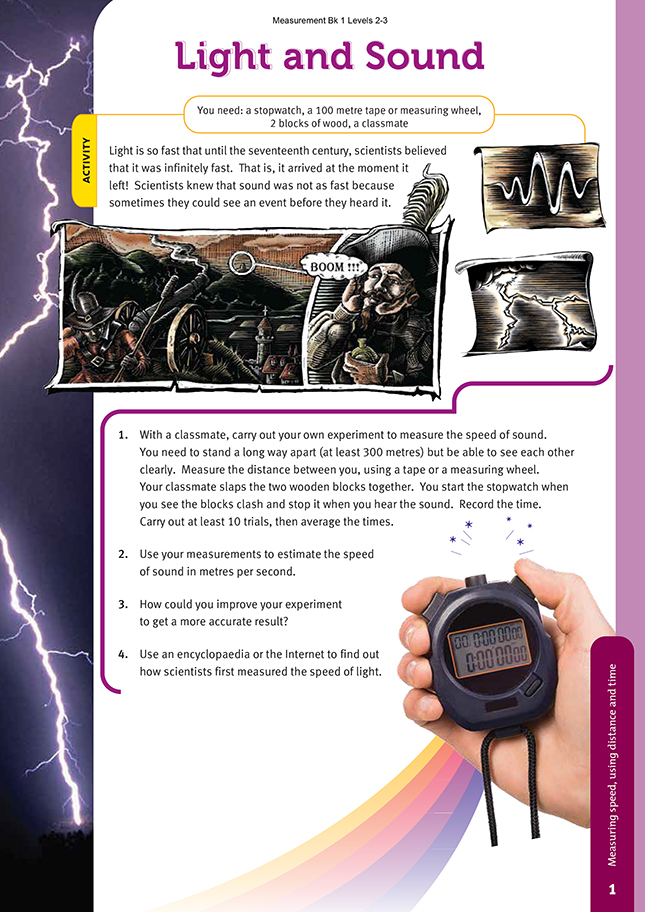This is a level 4 measurement strand activity from the Figure It Out series.
A PDF of the student activity is included.
Click on the image to enlarge it. Click again to close. Download PDF (294 KB)
measure time in milliseconds
a 100 metre tape or measuring wheel
stopwatch
FIO, Level 4+, Measurement, Book Two, Energy Crisis, page 1
2 blocks of wood
classmate
In this practical outdoor experiment, the students measure the time that elapses between observing an event and hearing the sound associated with it. By also measuring the distance involved, they calculate an approximate value for the speed of sound.
Introduce this activity by discussing with your students the delay between sight and sound. Most will know that we see lightning before we hear the thunder; they may also have seen the smoke from a starting pistol before hearing the "crack" or have seen a jet crossing above before hearing the sound of its engines. They may know that mountaineers and skiers can see an avalanche before they hear its roar. Because light travels extremely fast, we see things the moment they happen, but because sound travels relatively slowly, we hear things only after a delay. Another familiar phenomenon that demonstrates the relatively slow speed of sound is echo. Most students will have been in an environment where they have made a noise and then heard a distinct echo a second or two later. The delay is the time it takes for their voice to reach a reflecting surface and return to them.
Sound travels approximately 1 kilometre in 3 seconds, so it takes less than a second to travel 300 metres. The students will find it difficult to measure an interval of much less than a second, so the experiment in question 1 should be carried out over a distance of at least 300 metres. It may be best to measure out a suitable distance beforehand and to assign one or two people to be block slappers. This will mean that other members of the class can be at your end of the course, in small groups, sharing the timing and the recording.
You may want to agree on signals so that you can communicate with those at the far end, or you may wish to communicate using cellphone text messages. The students could record their timings on a standardised chart.
Question 2 can be done back in the classroom. If the students pool all their results and average them, they should get a fairly accurate timing for sound to travel the measured distance. They should then be able to use this to find a good approximation for the speed of sound in metres per second.
In question 3, the students are asked to think about how they might improve this experiment. They may suggest:
- Making a louder sound. The ideal is a starting pistol.
- Measuring out a longer distance. As long as there is a clear line of sight and a sound that is loud enough to carry, the greater the distance, the better.
- Waiting for a still day. Windy conditions make it difficult to hear the sound and distort the times.
Question 4 is a personal or pair investigation into how the speed of light was first measured. For a long time,it was believed that light was instantaneous. Galileo tried to time a light signal as it travelled from one hilltop to another, but no matter how far apart the signal and the observer were, there was no measurable delay. It was the Danish astronomer Ole Roemer who first realised that light did indeed have speed. Investigating the eclipses of Jupiter's moons, he observed that they sometimes came ahead or behind schedule. He correctly deduced that the cause must be the speed of light and came up with a surprisingly good estimate of that speed. Students who elect to investigate this story could present their findings to the rest of the class as a talk, computer presentation, or wall chart.
You could also challenge your students to investigate the speed of sound through other media, such as the pipe rail of a long fence, a disused railway line, or water.
Try to ensure that by the end of this activity, all students have learned that sound takes approximately 3 seconds to travel 1 kilometre. The next time they are in a thunderstorm, they can time the interval between the flash and the sound and know how far away the lightning is.
Cross-curricular links
Science
This activity could be part of a unit on light and sound.
Achievement Objective
- investigate and offer explanations for commonly experienced physical phenomena and compare their ideas with scientific ideas, (Making Sense of the Physical World, level 4)
Answers to Activity
1. Practical activity. Results will vary.
2. Results will vary, but they should be approximately 300 - 350 m/s.
For example, if, over four trials, the time for sound to travel 300 metres averages 0.9 seconds:
Speed = distance in metres ÷ time in seconds
= 300/0.9 or 300 ÷ 0.9
= 333 m/s
3. Results could be improved by increasing the distance and using a starting pistol instead of wooden blocks.
4. Individual activity
